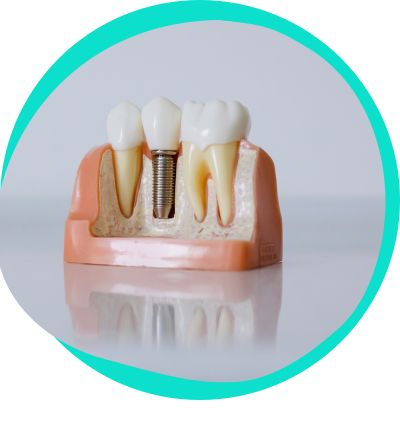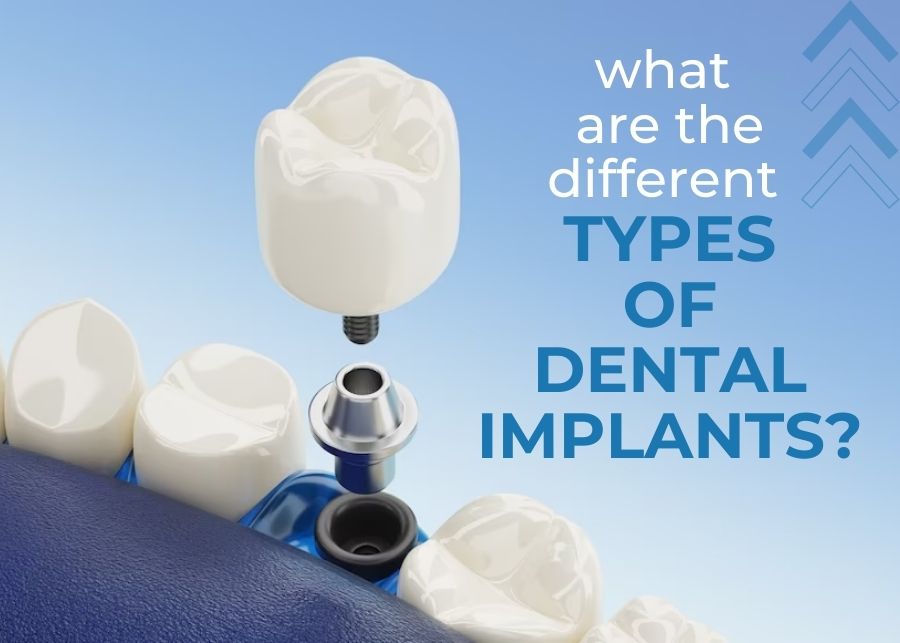There has been notable progress in the field of dentistry, and today, through a range of techniques and treatments, achieving a great smile is not impossible.
When it comes to tooth loss, dental implants have emerged as the preferred and highly recommended solution. These implants not only enhance the visual appeal of a person’s smile but also contribute to improved oral health, thereby positively impacting their overall well-being.
Dental implants stand out as the most authentic, visually pleasing, and durable option for replacing missing teeth. However, the array of choices available can be overwhelming.
Let’s take a thorough look at the different types of dental implants available to make your choice a bit easier.

Dental implants are prosthetic devices used to replace missing teeth. They are designed to function and resemble natural teeth, providing a long-term solution for tooth loss.
The implant post is a small, screw-like piece of titanium that is surgically inserted into the jawbone. This post acts as the artificial tooth root, providing a stable foundation for the replacement tooth.
Click here to learn more about the different benefits of tooth implants.
There are three different ways that implants can be inserted. These include Endosteal, subperiosteal, and zygomatic implants:
These are the most common types of dental implants. Although they are suited for most individuals, the patient needs a good, healthy jawbone for the post to fuse to. They are placed directly into the jawbone and are shaped like small screws.
After the procedure, it requires time to heal and fuse together to create a stronghold. Once it’s healed, the false teeth can be placed on the post to fit in with the surrounding teeth.
Different from endosteal implants, which are fixed into the jawbone, subperiosteal implants are placed on top of the jawbone.
This is the main alternative for endosteal implants. Patients who don’t have enough healthy jawbones to support the endosteal ones will typically go for this option.
A metal framework positioned atop the jawbone secures the implant in its position, while the implant’s posts extend through the gums.
This procedure should only be done if the patient doesn’t have enough jawbone for the Endosteal implant. The implant is placed in the patient’s cheekbone rather than the jawbone.
Zygomatic implants are the least common type of dental implant.
All-on-4 is a dental implant technique in which just four implants replace the upper or lower set of teeth. These four implants act as a support mechanism for the placement of a new set of fixed teeth. With this procedure, an entire row of teeth can be replaced in a very short period of time. Learn more about when is All-on-4 the best choice here.
Snap-On dentures consist of 2–6 implants placed in the patient’s mouth and a denture that simply snaps on the implants. These are a more secure type of implant that clips in place, but the patient will need to remove and clean them after bedtime like they would with a traditional denture. Learn more about the differences between snap-on dentures and all-on-4 implants here.
A standalone implant, known as a single-tooth implant, is used to replace a single missing tooth.
The implant is inserted into the jawbone, and a replacement tooth or crown is subsequently affixed to the implant post.
Single-tooth implants provide a durable and aesthetically pleasing remedy for tooth loss while also aiding in the preservation of the neighboring teeth and jawbone structure.
They serve as an excellent choice for patients with one or two missing teeth who desire a stable, permanent, and authentic-looking solution.
Implant Bridges
An implant bridge is a dental implant option that’s used to replace multiple teeth that are missing. It relies on the support of two or more dental implants, which are carefully positioned in the jawbone.
By connecting the bridge to these implant posts, a secure foundation is established to support the replacement teeth.
Implant bridges provide a durable and realistic solution for tooth loss while also aiding in the maintenance of the surrounding teeth and jawbone structure.
They are an excellent choice for individuals with consecutive missing teeth, as long as they still have healthy teeth on both sides of the empty space.
Immediate Load Implants (Teeth In a Day)
Immediate load implants, commonly referred to as “teeth in a day” implants, are a specific implant category that enables patients to receive replacement teeth immediately following implant surgery.
These implants are typically recommended for individuals with sufficient healthy jawbone structure to support the implant and who seek a convenient and time-efficient treatment alternative.
Additional Techniques for Dental Implants
In certain situations, patients may need an additional procedure to proceed with dental implant treatment. For example, if the patient’s jaw lacks the necessary support for traditional implants and Zygomatic implants are not suitable, there are alternative options available:
Bone Grafting
Bone grafting is a surgical intervention employed to reconstruct or rejuvenate a jawbone that has been lost as a result of injury, disease, or tooth extraction. This procedure is frequently required for individuals seeking dental implants but lacking sufficient healthy jawbone structure to support them.
Sinus Lift
A sinus lift consists of adding bone to the upper jaw in the area below the sinus.
When there’s not enough bone in that area, this procedure can be a possible solution.
It entails making a small incision in the gum tissue and adding a small quantity of bone to the site. The purpose of this procedure is to prepare the area for the subsequent placement of a dental implant.
Ridge Expansion
In some instances, the width of your jaw may not be adequate for implants. In such situations, your dentist can perform a grafting procedure, where additional material is inserted into a space created along the upper portion of your jaw.
Dental implant treatment is highly effective, to find out more about the different options and which one may be right for you, contact Parker Dental Implant and Specialty Center, call 720-522-2000, or visit us at 11005 S Parker Rd. Parker, Colorado.
At Parker Dental Implant and Specialty Center, our professionals will assess the overall oral condition of the patients to determine if a dental implant is appropriate. Safe and effective treatment is ensured.

